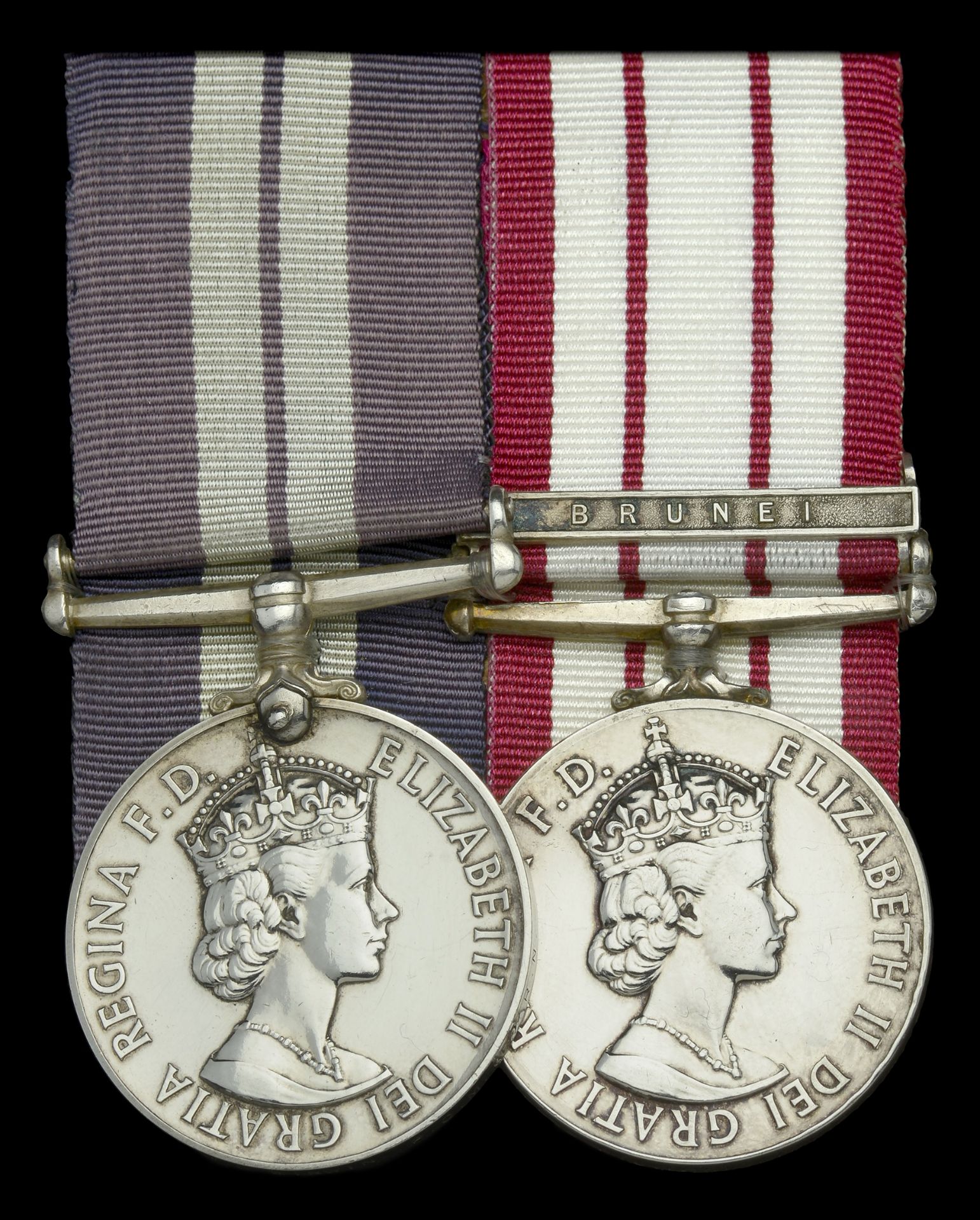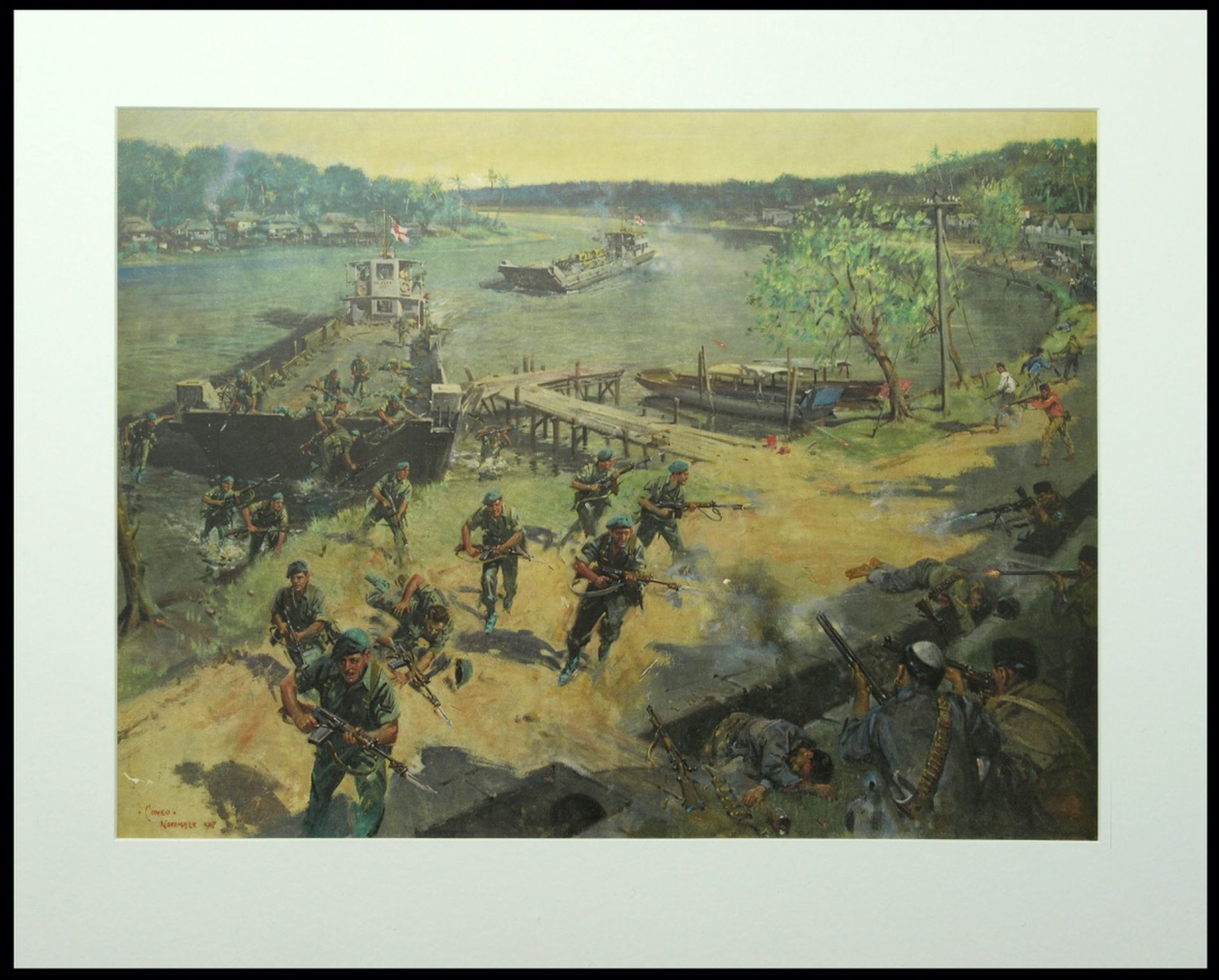‘After having heard the battle raging around his craft, he left his engines under the charge of his assistant, picked up his sten gun, and joined in the gun battle.’ The unique Brunei D.S.M. pair awarded to Petty Officer Mechanician P. J. D. Kirwin, Royal Navy, Stoker Petty Officer of the leading lighter at the opposed Royal Marines Commando raid against heavily armed Indonesian supported rebels at Limbang, Brunei, on 12 December 1962, who, ‘when his craft came under heavy fire, left the safety of his engine room, grasped his automatic weapon, and engaged the rebels himself at very close range’ - one of just four D.S.M.s awarded to the Royal Navy in the period from the Korean War in 1953 until the Falklands War in 1982 Distinguished Service Medal, E.II.R., 2nd issue (P/KX.869578 P. J. D. Kirwin. P.O.M. (E) R.N.); Naval General Service 1915-62, 1 clasp, Brunei (KX.869578 P. J. D. Kirwin. P.O.M. (E). R.N.) this with officially re-impressed naming, together with original Royal Mint case of issue for D.S.M., extremely fine (2) £16,000-£20,000 --- D.S.M. London Gazette 31 May 1963: ‘For gallant and distinguished services in operations in Brunei during the period 8th to 23rd December 1962.’ Revolt in Brunei Up to 1962, the island of Borneo was divided into the vast southern area under Indonesian rule and three British dependencies, Sarawak, North Borneo and, sandwiched between them, the tiny but very wealthy protectorate of Brunei. With the sun gradually setting on British interests in this part of the Far East, a proposal to include these three northern Borneo states into the new Federation of Malaysia was opposed by Indonesia which then proceeded to back the dissident TNKU in mounting an insurrection in Brunei with the aim of maintaining a North Borneo Union. To further this, in December 1962 the rebels occupied several towns, including Brunei town and at Limbang across the border in Sarawak, they held a number of hostages, including the British Government’s Agent - the ‘Resident’, ‘Dick’ Morris - his wife and a nursing sister. There were indications that the hostages were to be executed on 12 December. At this time 42 Commando, who were awaiting Christmas in Singapore, were put on short notice, and two days later ‘L’ Company, under Captain Jeremy Moore (later to command British Land Forces during the Falklands War), flew to Brunei Town where the Gurkhas had restored order. In fact, most of the trouble had been quickly stamped out, except at Limbang, only accessible by river. Amphibious Assault on Limbang Tasked with rescuing the Limbang hostages, Moore’s urgency was further sharpened when it was learned that the TKNU had murdered some hostages at Bangar. At the waterfront in Brunei he met the Senior Naval Officer, Lieutenant-Commander J. J. Black (who by coincidence would also rise to senior command during the Falklands War as Captain of the aircraft carrier H.M.S. Invincible) who had requisitioned two Z-Lighter landing craft for the raid, the Nakhoda Manis and the Sindaun, and provided these with five man crews from the minesweepers Fiskerton and Chawton under his command. Lieutenant Willis, being Black’s First Lieutenant, was appointed as the Senior Naval Officer charged with ensuring that the task force arrived off Limbang but once the assault landing was under way, the lighters would then come under the tactical direction of the senior Royal Marine on board. None of the Royal Navy men under Willis had any experience in handling Z-Craft or landing craft operations but they were now being committed to the daunting prospect of an opposed landing. At 10pm on 11 December, the understrength ‘L’ Company of 87 men, faces blackened, all wearing green berets with glinting cap badges for identification, filed on to the waiting Z-Craft. On board the lead lighter, Nakhoda Manis - commanded by Willis - was Captain Moore, his reconnaissance group, part of Company HQ, and 5 Troop. Also aboard as guide was Captain Muton, the Brunei Director of Marine who would later receive the M.B.E. for his efforts and four more Royal Navy crew including Petty Officer Mechanician Kirwin. The assault went in at first light: ‘When they were 300yds from the Limbang police station, and as the leading craft came abreast of the huts south of the town,‘it erupted like a disturbed ants' nest as the rebels stood to’. At 200yds the Commando Intelligence Sergeant called through the loud-hailer in Malay: ‘The rebellion is over . . . you should lay down your arms.' They replied with automatic weapons - an LMG, three or four SMGs - and some dozen rifles, supported by over 100 shotguns. The instantaneous counter-fire from both craft gave the commandos, thanks to their Vickers machine-guns, the initiative, enabling the leading craft to beach half a minute later only 30yds from the police station. Two marines of the leading No.5 Troop were killed before the craft gained the bank and their OC, Lt ‘Paddy’ Davis, was wounded as he jumped ashore. Sgt Bickford led two Sections of the Troop against the police station, which was quickly cleared, but the naval coxswain of the leading craft had been wounded and as the craft drifted off the bank, Lt D.O. Willis, RN, drove it hard back ashore; but this shallow draught lighter broached to 150yds upstream between the hospital and the home of the British Resident. Capt Moore sent the reserve section ashore, with HQ personnel led by TSM McDonald, and they cleared the hospital. As they came through to the back of this building, the Troop sergeant and two marines were killed, ‘for the jungle comes literally right down to the back door of the hospital’. The grounding of the craft up-river had been a fortunate accident, for Capt Moore found some of the hostages in the hospital. A rebel had fired at them but missed, and no one was hurt. While the ground between the hospital and the police station was being cleared, as was the Resident’s house, the Company Commander was told of more hostages. Therefore, he organised the clearing of the rest of the town to the south, and by the afternoon had released another eight hostages but at nightfall there were still rebels inside the Company’s perimeter, two of whom were killed close to the marines’ positions. Next day the town was secured. Five marines had been killed and six wounded (including a sailor), but the action here, coupled with those of the Gurkhas and Queen's Own Highlanders elsewhere in Brunei, had broken the rebellion. At Limbang alone 15 rebels had been killed and 50 captured from a force of 350, - twice the expected size. They had been taken by surprise, as the commandos now discovered. The Vickers guns in the second craft had been masked, the Company Commander also learnt, by the leading craft, until QMS Cyril Quoins asked the officer commanding this lighter if he could pull out of line to give them a clearer shot. ‘Sergeant Major’, the officer replied, ‘Nelson would have loved you’, and promptly swung his craft into a more exposed position.’ (The Royal Marines by James D. Ladd refers.) It is also worth quoting Captain Jeremy Moore’s observations, made much later: ‘It is perhaps interesting to note that, though my assessment of where the enemy headquarters might be was right, I was quite wrong about the hostages. Furthermore, it was chance that the second beaching happened where it did, that resulted in us taking the hospital from the direction we did. It could be that this saved us heavier casualties, though I assess the most important factor in the success of the operation was first class leadership by junior NCOs. Their section battle craft was a joy to watch...







